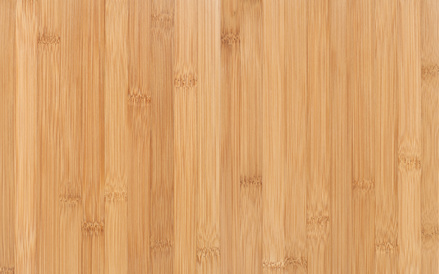BAMBOO FLOORING
The subject of bamboo flooring is a fascinating one and is perhaps one of the least understood of alternative wood flooring options.
IS BAMBOO AS DURABLE AS WOOD?
Bamboo flooring is not wood flooring. When used as an alternative to hardwood flooring, the question would be whether or not it is as durable as wood. Solid hardwood flooring is unquestionably durable. Sealing the wood only increases its hardness and durability.
But bamboo is a plant, made of stalks and is a member of the grass family. How can it be as durable as wood?
AND THE ANSWER IS...
The answer lies in the quality of the bamboo, the placement of the stalks, and the adhesives used to hold the stalks together.
Quality of the Bamboo
Though it can be hard or even impossible to always determine the quality of the bamboo being purchased, it has been shown that bamboo that is harvested late is more durable than younger bamboo harvested early. The younger bamboo can become cupped or warped over time. This is why it is important to buy from a reputable dealer and look for the Forest Stewardship Council (FSC) Seal.
Construction and Placement of the Stalks.
There are 2 types of construction:
- Solid bamboo flooring begins by slicing the stalks into thin strips of a certain length. The outer skin is removed and the strips are boiled in boric acid to remove any starches and then are laid out to dry. They are then coated in an adhesive resin and pressed together either horizontally or vertically. The material goes through heat binders, is then planed and sanded and a light UV lacquer is applied. The planks are sanded smooth and can be finished as desired. The plank strips are then nailed to wooden beams or larger bamboo pieces.
- There is also strand bamboo flooring or woven strand bamboo flooring. With this type of bamboo construction, the stalks are sliced into thin strips and treated for insects or vermin. The strips will often be boiled and may be dipped in borax. The stalks are then pulled apart and shredded and then tightly integrated with adhesives. The fibers are formed into boards under high pressure and then treated with a preservative. Because this type uses not just the stalks, but also the smaller strands and is combined with adhesives, it makes a stronger product. (Strand woven bamboo is high on the Janka Hardness Scale at 2000-3200, right up there with Brazilian cherry and teak. One type of bamboo is advertised at 5000 on the Janka scale!)
- Adhesives. Ultimately, it is the man-made adhesives that hold the stalks together that make bamboo flooring hard and durable. It is unfortunate, however, that the urea-formaldehyde adhesives used can emit volatile organic compounds (VOCs) into the interior space (sometimes more than that found in manufactured wall-to-wall carpeting). The toxicity of the adhesive will depend on the manufacturer and that is why it is important to find a reputable dealer so you can be sure your bamboo flooring has been produced with the highest environmental standards.
BAMBOO COMPARED TO WOOD FLOORING
When comparing bamboo to wood flooring, the major difference seems to be in colors and finishes. While they are both durable and attractive, bamboo floors are limited to only a few shades, light blonde (natural) or a medium brown which is produced by heating the bamboo in a process called carbonization, which also makes it slightly softer. Hardwood floors come in many varieties of colors and finishes.
INSTALLATION
Either the strands or the stalks can be installed vertically or horizontally, depending upon the preference of the consumer. The vertical gives a more textured look. The horizontal is what one would expect a bamboo floor to look like.
The most common type of bamboo flooring used in Asia is one where the arrangement of the planks is loose, producing irregular gaps throughout. This type of floor breathes, which will keep a room cooler and more ventilated in the summer.
When Engineered Bamboo Flooring is manufactured, the stalks go through slicing, treating, and being adhered together as for solid bamboo flooring. The difference is the planks are sliced down into thin horizontal layers and then installed on backing material such as plywood or fiberboard with heat, pressure, and adhesive.
IS BAMBOO FLOORING
A 'GREEN' CHOICE?
This type of flooring is unique and aesthetically appealing as a floor covering and has become very popular in recent years. It is a 'sustainable, renewable' product since it matures in 3-5 years when it is ready to be made into flooring. But there are some murky questions lurking about its choice as a 'green' one.
The adhesives used in the manufacture of this product are definitely not 'green' and may contain VOCs and/or formaldehyde. As mentioned above, the durability of bamboo floors varies too much and is totally dependent upon the treatment of the bamboo with adhesives.
Most of the bamboo comes from China which has a history of human rights abuses, suspect politics, and a poor environmental record, questioning the choice of bamboo flooring as an 'ethical' one.
There has been progress made recently. Check to see if the grower and manufacturer of the bamboo has achieved certification from the Forestry Stewardship Council (FSC) for their practices. Some manufacturers are beginning to use healthier formulations of formaldehyde as well.
Bamboo is currently listed as a green material by the Leadership in Energy and Environmental Design or LEED, a building certification process. There are other options to bamboo, such as eucalyptus, cork, and reclaimed hardwoods which may be green or greener than bamboo.
ADVANTAGES OF BAMBOO AS A
FLOORING PRODUCT
- Bamboo is a very fast-growing plant, maturing in 3-5 years.
- It is a very hardy plant and because the root does not have to be removed at harvest, it does not have to be planted each season.
- Harvesting is good for the environment because removing the large bamboo stalks allows sunlight to filter down and reach some of the smaller plants and foliage.
- Bamboo has very long roots that spread out with spider-like veins. These hold the soil together and combat erosion which is good for the ecology of a system.
- Bamboo is biodegradable and will break down over time in a landfill
- One important advantage of bamboo is that it has been shown to hold more carbon than trees so it does tend to help ward off global climate change.
- It is also able to generate 35% more oxygen than the same amount of planted trees.
SOME SERIOUS DOWNSIDES TO USING BAMBOO AS A FLOORING PRODUCT
- Bamboo has become so popular that it has spread into fields traditionally used for other foliage. This hurts biodiversity and changes the ecological balance of the environment.
- While, as mentioned above, bamboo is a fast-growing plant, sometimes that growth may be augmented even more with synthetic fertilizers and pesticides.
- Harvesting and manufacturing need to be regulated or rated by the FSC Forest Stewardship Council, which at this time is not widespread. This makes it impossible to know whether or not the bamboo was harvested ecologically responsibly and sustainably.
- No fair trade certification means no way to know whether the workers harvesting are being fairly treated.
- Formaldehyde and VOCs. The higher the quality of the bamboo, the less toxic will be the adhesives, the formaldehyde, and VOCs.
- Transportation. Bamboo comes from SE Asia and the carbon emissions given off during the transportation process can affect its ecological viability.
CLEANING & MAINTENANCE
- No wet mopping. Even though Bamboo is more dense and water resistant than most other woods, it cannot be installed in a wet environment where liquids sit on the surface of the floor. This includes areas of high humidity (water in the air) as well. The damage can include warping and staining and can also lead to the growth of mold and mildew in the sub floor.
- Sweeping and vacuuming regularly will help to get rid of small dirt particles and debris that can cause scratches that will dig down into the finish when walked on, which will give the bamboo a faded look. Do not use a vacuum with a beater bar.
- Occasional damp mopping is fine, but any remaining liquid should be wiped free immediately.
- Only non-alkaline, non-abrasive cleaners and no floor wax should be used on a bamboo floor. Do not use oil soap or scouring powder. If the cleaning agent needs to be mixed with water, follow the directions very carefully. After cleaning with any liquid, use a dry towel to wipe up any excess moisture.
- Natural bamboo cleaning solution – Mix ¼ cup of white vinegar into a quart of water. Apply using a damp sponge or rag wrung dry before applying and wipe up any excess immediately.
- Bamboo can be subject to scratches, dents, and cracks under certain conditions such as pet claws, etc. Refinishing the floors periodically will help to revitalize the look of the product.
If properly installed and cared for, a bamboo floor can last for up to 30 years.
"The Cleanest Clean You've Ever Seen."
by
ABC Oriental Rug & Carpet Cleaning Co.
130 Cecil Malone Drive Ithaca, NY 14850
607-272-1566
Make sure to click on full-screen for this short movie about bamboo!

ABC
Carpet & Rug
Spotting Guide



